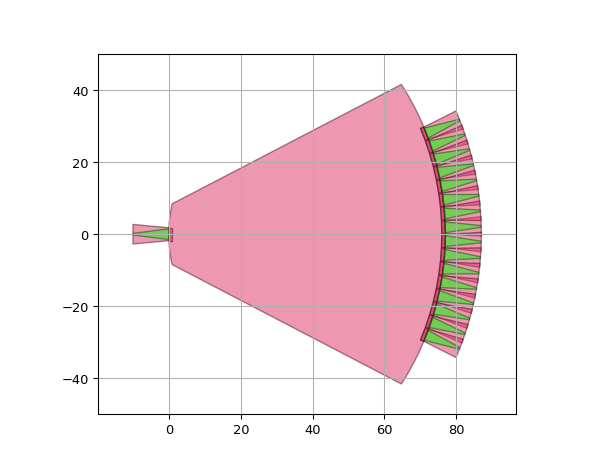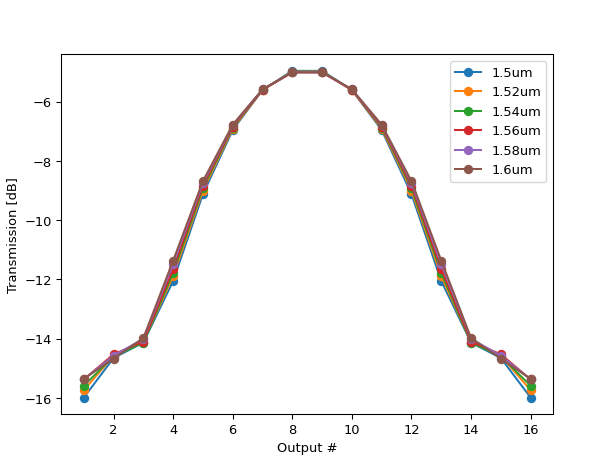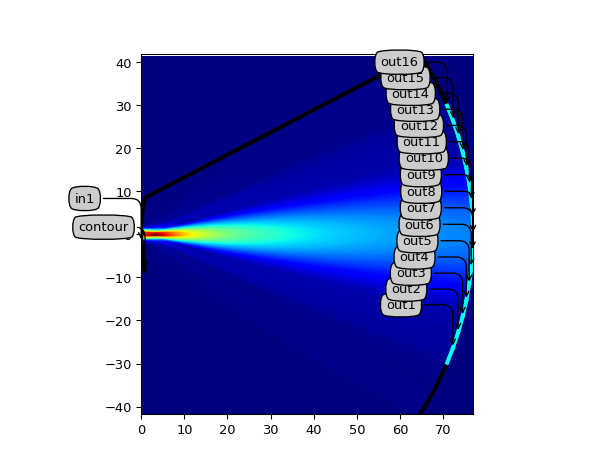StarCoupler
- class awg_designer.all.StarCoupler
The StarCoupler is a combination of the
MultiApertureand the free propagation region. The StarCoupler places theMultiAperturecells and generates the free propagation region in between. The CircuitModel view is capable of simulating the full star coupler. This is done by getting the field output of the input apertures, propagating it in the free propagation region, and performing mode overlaps to collect the fields at the output apertures. Setsimulation_wavelengthsto the desired wavelength grid in order to calculate the physical model for the star coupler at those exact wavelengths. The model will interpolate and extrapolate from those wavelengths. If a single wavelength is specified, the model will be wavelength independent.- Parameters:
- aperture_out: PCell, required
(Multi) output aperture
- aperture_in: PCell, required
(Multi) input aperture
- aperture_out_ports: List with type restriction, allowed types: <class ‘str’>
list of the output aperture port names that are connected to the outside world. The order of this list will determine the numbering of the output ports
- aperture_in_ports: List with type restriction, allowed types: <class ‘str’>
List of the input aperture port names that are connected to the outside world. The order of this list will determine the numbering of the input ports
- slab_template: PCell and SlabTemplate
template for free propagation region
- external_port_names: str
Map of the free instance terms/ports to the names of external terms/ports.Format is a dict {‘inst:term’ : ‘new_term_name’}.If a term/port is not listed, the format instname_portname will be used
- name: String that contains only ISO/IEC 8859-1 (extended ASCII py3) or pure ASCII (py2) characters
The unique name of the pcell
- Other Parameters:
- free_propagation_region: PCell and _FreePropagationRegion, locked
unpatterned slab section. This subcomponent is generated automatically to connect elements together.
- links: locked
Logical links between free_propagation_region and apertures
- child_cells: locked
Instances of child cells in FreePropagationCell composed of input apertures ,scatters and free_propagation_region.
- scatterers: locked
- apertures: locked
- n_outputs: locked
number of output ports
- n_inputs: locked
number of input ports
Views
- class Layout
- Parameters:
- hull_stub_width: float and number > 0
- hull_growth: float and int, float, integer, floating and number >= 0
- hull_extension: float and int, float, integer, floating and number >= 0
- aperture_out_transformation: GenericNoDistortTransform
- aperture_in_transformation: GenericNoDistortTransform
- contour: Shape
Contour of the Free propagation Region
- view_name: String that contains only alphanumeric characters from the ASCII set or contains _$. ASCII set is extended on PY3.
The name of the view
- Other Parameters:
- child_transformations: locked
dictionary with the transformation of each child instance.
- scatterer_transformations: locked
- aperture_transformations: locked
- class SlabFieldModel
- Parameters:
- layout_view: _LayoutView
- n_o_passes: int and number > 0
number of simulation passes
- space: _SlabPropagationEngine.Space
Space with all the elements representing the PCell
- engine: _SlabPropagationEngine
Slab simulation engine
- slab_modes: SlabModeDict
dict of Slab Modes
- view_name: String that contains only alphanumeric characters from the ASCII set or contains _$. ASCII set is extended on PY3.
The name of the view
- class CircuitModel
Circuit model for the star coupler. Simulates the apertures and the slab region. The CircuitModel of the StarCoupler simulates the following cells:
Apertures: the apertures are by default simulated using eigenmode expansion (camfr). See for example,
OpenWireWgAperture. The results is a mode profile at the output aperture, and the transmission (amplitude/phase) from the input port to the aperture.Slab region: The slab region is simulated by default using a Rayleigh-Sommerfeld engine. The input is the field profiles from the apertures. Then, RS is used to propagate the fields in the slab. Then, a modal overlap is performed of the fields at the location of the output apertures with the output aperture mode.
- Parameters:
- simulation_wavelengths: ( list<int, float, integer, floating and number > 0> ), *None allowed*
Wavelengths for which to simulate the underlying physical model.Defaults to None, in which case a physical simulation will be done for each requested wavelength.If a single wavelength is specified, the model will be wavelength independent.If multiple wavelengths are given, only these wavelengths are valid.
- layout_view: ( _LayoutView ), *None allowed*
- netlist_view: ( NetlistView ), *None allowed*
- view_name: String that contains only alphanumeric characters from the ASCII set or contains _$. ASCII set is extended on PY3.
The name of the view
- Other Parameters:
- solver: str and String that contains only ISO/IEC 8859-1 (extended ASCII py3) or pure ASCII (py2) characters, locked
circuit solver to use
Examples
import si_fab.all as pdk # noqa: F401 from ipkiss3 import all as i3 from pysics.basics.environment import Environment from awg_designer.all import ( OpenWireWgAperture, StarCoupler, get_star_coupler_apertures, get_star_coupler_extended_contour, SimpleSlabMode, SlabTemplate, ) import numpy import matplotlib.pyplot as plt # Template for the free propagation region # This defines the layers, slab modes, etc. slab_t = SlabTemplate() slab_t.Layout(slab_layers=[i3.PPLayer(i3.TECH.PROCESS.WG, i3.TECH.PURPOSE.DF_AREA)]) slab_t.SlabModes(modes=[SimpleSlabMode(name="TE0", n_eff=2.8, n_g=3.2, polarization="TE")]) # Specify the wavelength of interest environment = Environment(wavelength=1.55) # Make an aperture consisting of a transition between two trace templates ap = OpenWireWgAperture(slab_template=slab_t) ap_lo = ap.Layout(aperture_core_width=3.0, aperture_edge_width=0.3, transition_length=10.0) # ap_lo.visualize() # Get the field profile at the aperture # this will execute a CAMFR simulation ap_sm = ap.FieldModelFromCamfr() f = ap_sm.get_fields(environment=environment) # noqa:F841 # f.visualize() # Plot the full field inside the waveguide aperture: f2d = ap_sm.get_aperture_fields2d(environment=environment) # noqa:F841 # f2d.visualize() # Show the far field ff = ap_sm.get_far_field(environment=environment) # ff.visualize() div_angle = ff.divergence_angle() print("1/e2 divergence angle of aperture mode", div_angle) # Make a multi-aperture consisting of 16 apertures like these, arranged in a circle, # and get the transformations of the individual apertures N = 16 angle = 2 * div_angle # spread angle angles = numpy.linspace(-0.5 * angle, 0.5 * angle, N) radius = ap_lo.width * N / numpy.radians(angle) apm, _, trans_arms, trans_ports = get_star_coupler_apertures( apertures_arms=[ap] * N, apertures_ports=[ap], angles_arms=angles, angles_ports=[0], radius=radius, mounting="rowland", input=True, ) # Make a star coupler sc = StarCoupler(aperture_in=ap, aperture_out=apm) sc_lo = sc.Layout( contour=get_star_coupler_extended_contour( apertures_in=[ap], apertures_out=[ap] * N, trans_in=trans_ports, trans_out=trans_arms, radius_in=radius / 2.0, radius_out=radius, extension_angles=(10, 10), ) ) sc_lo.visualize() # Circuit Model: Calculate the S-matrix of the star coupler sc_cm = sc.CircuitModel(simulation_wavelengths=None) wavelengths = numpy.linspace(1.5, 1.6, 6) s_matrix = sc_cm.get_smatrix(wavelengths=wavelengths) # Plot transmission in the outputs plt.figure() for i_wl, wl in enumerate(wavelengths): t_outputs = [s_matrix["in1", f"out{i}"][i_wl] for i in range(1, N + 1)] plt.plot(range(1, N + 1), 10 * numpy.log10(numpy.abs(t_outputs)), "o-", label=f"{wl}um") plt.xlabel("Output #") plt.ylabel("Transmission [dB]") plt.legend() plt.show()


# Full field simulation sc_sm = sc.SlabFieldModel() sim = sc_sm.get_field_simulation(environment, "in1", grid=(0.5, 0.5)) sim.run() sim.monitors["fields"].get_result().visualize(overlays=[sim.space])
